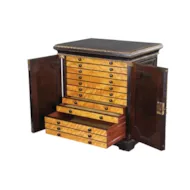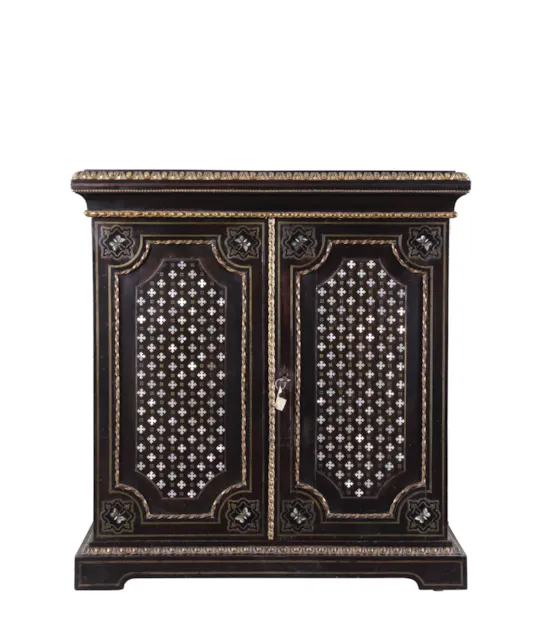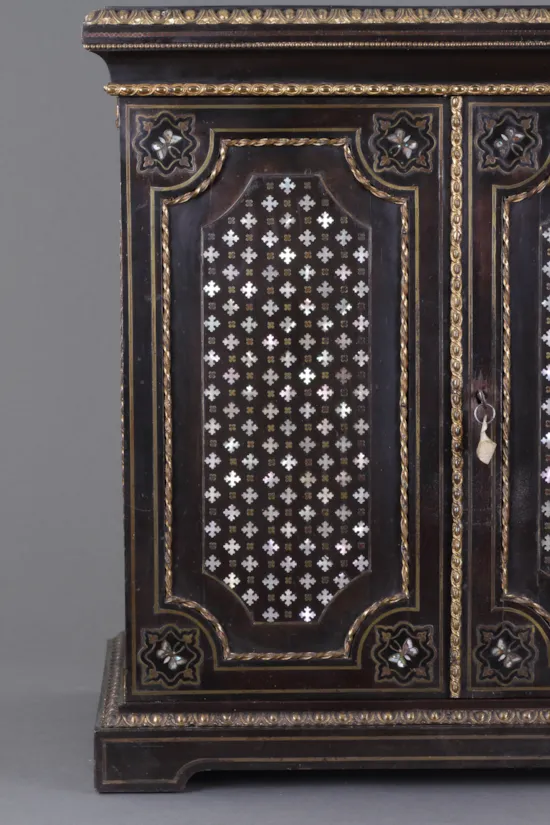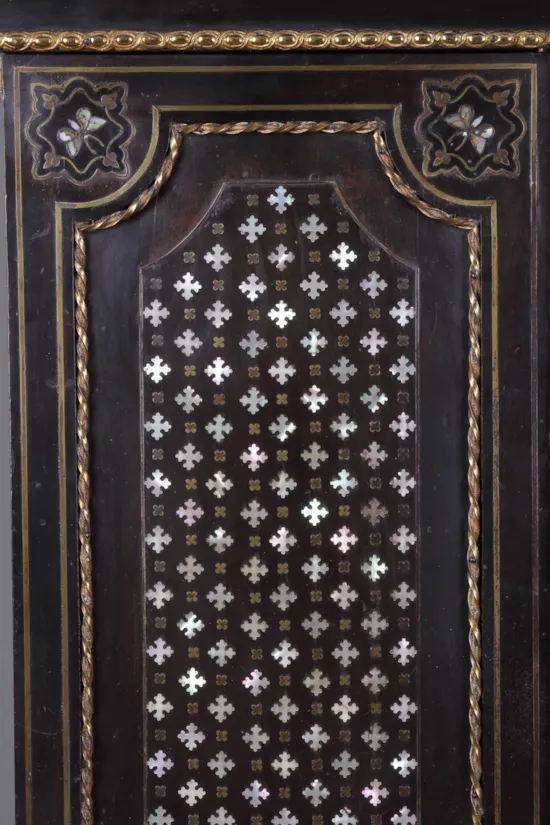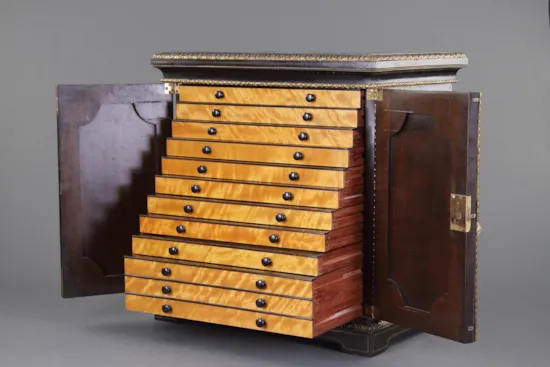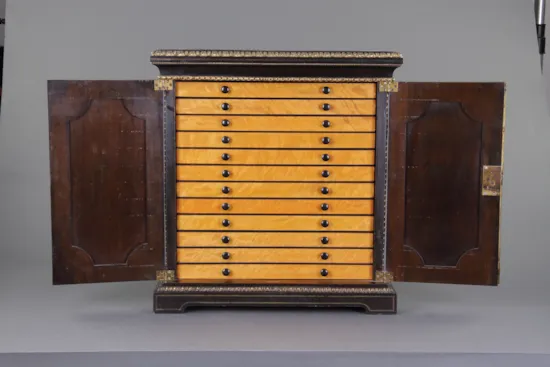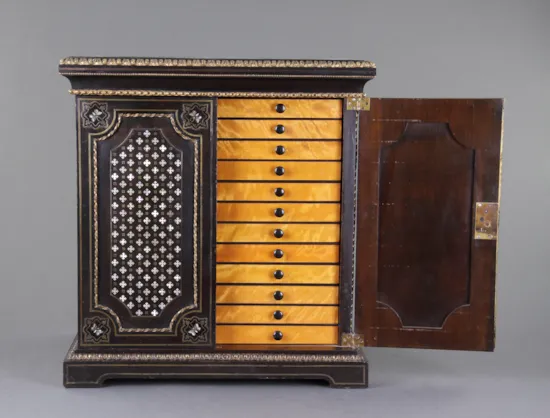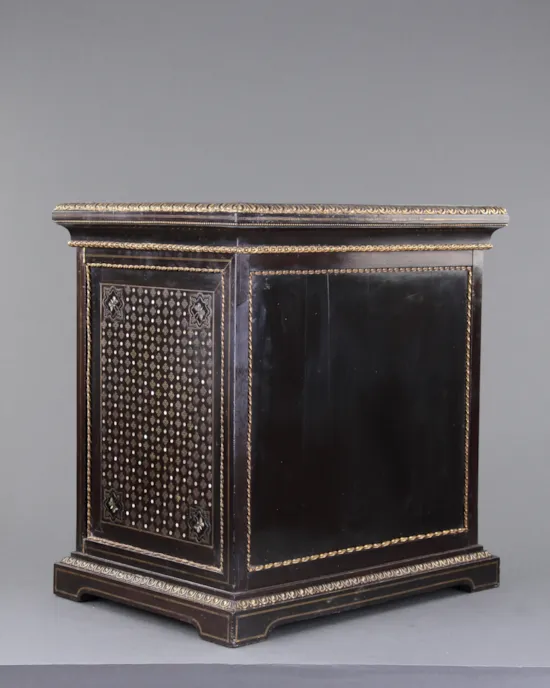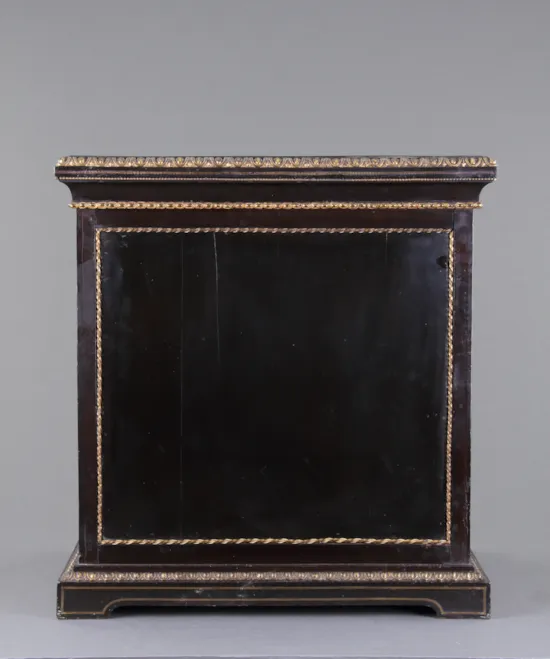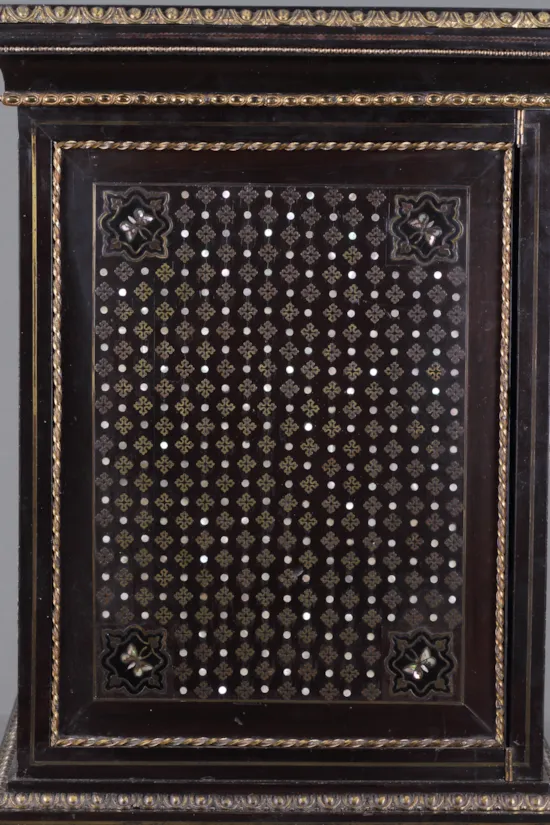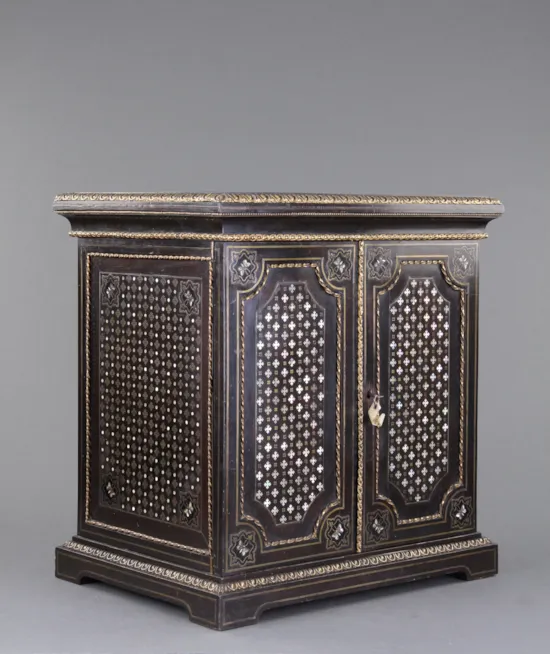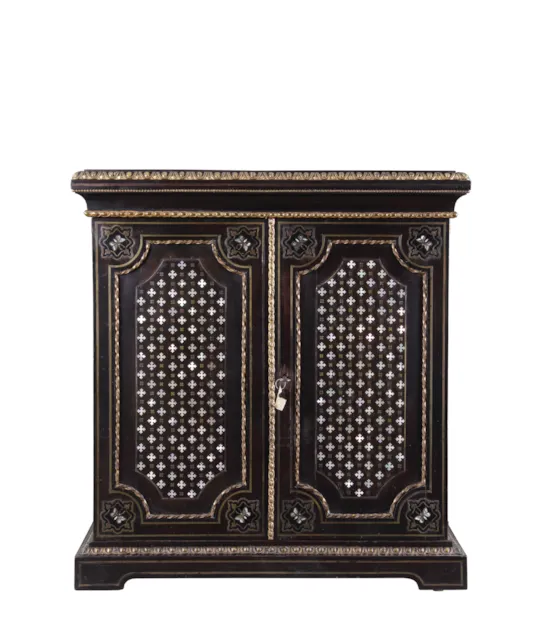Fine French Ebony Collectors Cabinet with Brass Inlay Decoration Mother-of-Pearl and Ormolu Twisted Rope and Bead Borders
A Fine French Ebony Collectors Cabinet with Brass Inlay Decoration Mother-of-Pearl and Ormolu Twisted Rope and Bead Borders
Attributed to the workshop of Maison Alphonse Giroux
The double fronted doors revealing ten maple veneered graduated drawers with ebony turned handles
Each drawer lined with a thick ‘cushioned’ green velvet liner
The doors top panel and side panels all decorated with brass and mother-of-pearl inlay bordered by four ‘butterfly’ inlaid motifs to each door and panel
Original lock-plate and key
Paris France
Mid 19th Century
Size: 47cm high, 44cm wide, 33cm deep - 18½ ins high, 17¼ ins wide, 13 ins deep
Attributed to the workshop of Maison Alphonse Giroux
The double fronted doors revealing ten maple veneered graduated drawers with ebony turned handles
Each drawer lined with a thick ‘cushioned’ green velvet liner
The doors top panel and side panels all decorated with brass and mother-of-pearl inlay bordered by four ‘butterfly’ inlaid motifs to each door and panel
Original lock-plate and key
Paris France
Mid 19th Century
Size: 47cm high, 44cm wide, 33cm deep - 18½ ins high, 17¼ ins wide, 13 ins deep
A Fine French Ebony Collectors Cabinet with Brass Inlay Decoration Mother-of-Pearl and Ormolu Twisted Rope and Bead Borders
Attributed to the workshop of Maison Alphonse Giroux
The double fronted doors revealing ten maple veneered graduated drawers with ebony turned handles
Each drawer lined with a thick ‘cushioned’ green velvet liner
The doors top panel and side panels all decorated with brass and mother-of-pearl inlay bordered by four ‘butterfly’ inlaid motifs to each door and panel
Original lock-plate and key
Paris France
Mid 19th Century
Size: 47cm high, 44cm wide, 33cm deep - 18½ ins high, 17¼ ins wide, 13 ins deep
Attributed to the workshop of Maison Alphonse Giroux
The double fronted doors revealing ten maple veneered graduated drawers with ebony turned handles
Each drawer lined with a thick ‘cushioned’ green velvet liner
The doors top panel and side panels all decorated with brass and mother-of-pearl inlay bordered by four ‘butterfly’ inlaid motifs to each door and panel
Original lock-plate and key
Paris France
Mid 19th Century
Size: 47cm high, 44cm wide, 33cm deep - 18½ ins high, 17¼ ins wide, 13 ins deep
Maison Alphonse Giroux was established in 1799 by Francois-Simon-Alphonse Giroux (1776 - 1848), an art restorer, cabinet maker and one of the official restorers for the Notre Dame Cathedral. Based at 7, Rue du Coq-Saint-Honoré in Paris, the business initially started selling artist’s supplies, as well the products of his cabinetmaking work. However the business soon expanded into the manufacturing and retailing of luxury goods and artwork, attracting the attention of members of the royal French families. His sons Alphonse-Gustave and André joined the business in 1834. Upon the retirement of Francois-Simon-Alphonse Giroux in 1838, the eldest son, Alphonse-Gustave Giroux, took over the business as named ‘Alphonse Giroux et Cie’. Under his control, the business gained further acclaim for the quality of their work and merchandise, winning a silver medal at the 1839 Exposition des Produits de L’industrie Française. In 1839, Louis-Jacques-Mande Daguerre, inventor of the Daguerrotype photographic process and its associated camera, signed one of two exclusive contracts with Alphonse-Gustave Giroux (his brother-in-law), to manufacture and retail the camera through his business. In 1857, the business moved to 43 Boulevard des Capucines in Paris, their exclusive department store, extending to the adjacent Rue Neuve des Capucines 24. In 1867 the business was taken over by Duvinage and Harinckouk.
In the 18th and 19th centuries the concept of a cabinet of curiosities began to change and this lead to the separation of ‘naturalia, artificialia’ and ‘miribilia’ into different spaces and eventually into different museums. In the 1706 illustration of Level Vincent’s Natural History Collection there are portrayed jars of preservative fluid containing various small animals, frogs, snakes and inset in the middle of the display a baby’s head with the bizarre addition of a lace cap.
For collectors, the object in the cabinet offered a metaphor for the unknown. The culture of collecting, the seeking out, sorting, organising, displaying, storing and cataloguing of items of natural, scientific, archaeological or aesthetic interest is an ancient and deeply rooted psychological need, even prehistoric man is said to have made collections of found objects. The scope of collecting is unlimited with some people arbitrarily accumulating many objects that meet a general thematic requirement.
Other collectors known as ‘completists’ aim to acquire all the items in a well defined set, whilst others seek a limited number of items per category. Sometimes monetary value, quality and condition is important, but is irrelevant to others. Collecting is usually a lifelong pursuit, and is always a passionate expression of a desire for knowledge, order and beauty.
A strong interest in antiquity introduced a taste for collecting cameos, bronze plaquettes, coins and medallions, and cabinets such as this were deemed suitable for ‘masculine’ surroundings such as libraries in which to house such varied collections.
In the 18th and 19th centuries the concept of a cabinet of curiosities began to change and this lead to the separation of ‘naturalia, artificialia’ and ‘miribilia’ into different spaces and eventually into different museums. In the 1706 illustration of Level Vincent’s Natural History Collection there are portrayed jars of preservative fluid containing various small animals, frogs, snakes and inset in the middle of the display a baby’s head with the bizarre addition of a lace cap.
For collectors, the object in the cabinet offered a metaphor for the unknown. The culture of collecting, the seeking out, sorting, organising, displaying, storing and cataloguing of items of natural, scientific, archaeological or aesthetic interest is an ancient and deeply rooted psychological need, even prehistoric man is said to have made collections of found objects. The scope of collecting is unlimited with some people arbitrarily accumulating many objects that meet a general thematic requirement.
Other collectors known as ‘completists’ aim to acquire all the items in a well defined set, whilst others seek a limited number of items per category. Sometimes monetary value, quality and condition is important, but is irrelevant to others. Collecting is usually a lifelong pursuit, and is always a passionate expression of a desire for knowledge, order and beauty.
A strong interest in antiquity introduced a taste for collecting cameos, bronze plaquettes, coins and medallions, and cabinets such as this were deemed suitable for ‘masculine’ surroundings such as libraries in which to house such varied collections.
Ex Private English collection
Fine French Ebony Collectors Cabinet with Brass Inlay Decoration Mother-of-Pearl and Ormolu Twisted Rope and Bead Borders
